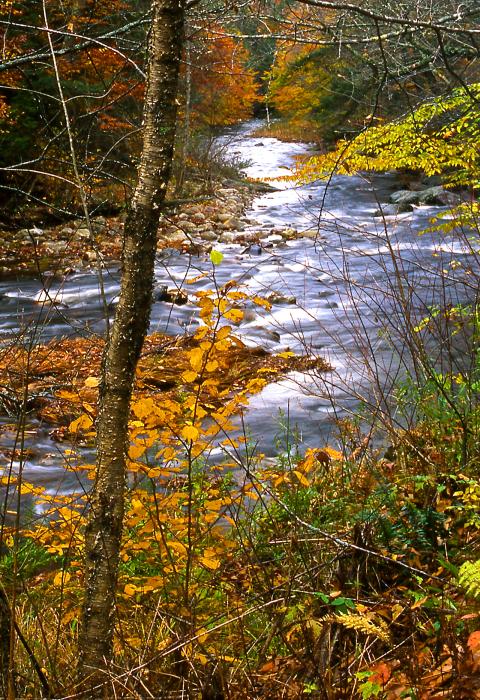Westfield River
Massachusetts
From its origins in the Berkshire Hills in western Massachusetts, the Westfield River links together historic villages, prime farmland, pristine wilderness areas, and waterfalls and gorges of remarkable quality. The river features native trout fishing, rugged mountain scenery, and a historical mill town settlement. The Westfield River provides over 50 miles of the Northeast's finest whitewater canoeing and kayaking. The river corridor also contains one of the largest roadless wilderness areas remaining in the state and is home to several endangered species.
The Westfield is a state and locally managed river. Through the locally initiated designation, community members, municipal officials, conservation organizations, and federal and state agencies have come together to manage and protect this national treasure. Members of the Westfield River Wild & Scenic Advisory Committee lend their eyes, ears, and voices for the river. Serving as liaisons to their respective communities and organizations, committee members raise awareness about the Westfield River and its resources and advocate for their preservation and protection.
The Westfield River designation stretches over 78 miles along the river's main stem and its East, Middle, and West Branches. The corridor width is 200 feet wide from mean high water, corresponding to the width of the Massachusetts River Protection Act.
Designated Reach
November 2, 1993, and September 28, 2004. The designated segments include:
- The West Branch from a railway bridge 2000 feet downstream of the Becket Town Center to the Huntington/Chester town line.
- The Middle Branch from the Peru/Worthington town line downstream to the confluence with Kinne Brook in Chester.
- Glendale Brook from Clark Wright Road bridge to its confluence with the Middle Branch.
- The East Branch from the Windsor/Cummington town line to a point 0.8 miles upstream of the confluence with Holly Brook in Chesterfield.
- Headwater tributaries of the East Branch including:
- Drowned Land Brook from its headwaters in Windsor to the confluence with the East Branch in Savoy.
- Center Brook from its headwaters below a pond near Savoy Center to its confluence with the East Branch.
- Windsor Jambs Brook from the junction of Phelps Brook and Clear Brook to its confluence with the East Branch in Windsor.
- The upper East Branch from the confluence with Drowned Land Brook in Savoy to the Windsor/Cummington Town Line.
- The lower East Branch from Sykes Brook in Huntington to the confluence with the West Branch.
- The lower Middle Branch from the Goss Hill Road Bridge downstream to the confluence with the East Branch.
- Headwater tributaries of the West Branch, including:
- Shaker Mill Brook from Brooker Hill Road in Becket to its confluence with the West Branch.
- Depot Brook from its headwaters near Beach Road in Washington to the confluence with Shaker Mill Brook in Becket.
- Savery Brook from the headwaters off Pittsfield Road in Washington to the confluence with Shaker Mill Brook.
- Watson Brook from the headwaters off Stanley Road in Washington to the confluence with Shaker Mill Brook.
- Center Pond Brook from Center Pond to its confluence with the West Branch.
- The lower West Branch from Chester/Huntington town line downstream to the confluence with the Main Stem.
- The main stem from the confluence with the East Branch and Middle Branch in Huntington Center downstream until the Huntington/Russell town line.
Outstandingly Remarkable Values
Geology
Windsor Jambs Brook, located in Windsor State Forest, provides a spectacular 25-foot-wide gorge, with 80-foot-high perpendicular granite walls. The brook flows through a series of cascading falls, the highest drop being about 50 feet. Glendale Falls is the highest waterfall in the state. Worthington Falls, on the Middle Branch in West Worthington, is an exemplary geological feature, with low cascades and undeveloped, hemlock-lined banks.
History
A National Historic Register District composed of ten keystone arch railroad bridges is located on the West Branch of the Westfield River. Evidence of several mills along the Westfield River and Drowned Land Brook still remain.
Sawmills, woodworking mills, a tannery, a scythe stone factory, and a wagon shop once thrived in the town of Windsor. Remnants of the old industries can be found throughout Windsor State Forest and The Trustees of Reservations' Notchview Reservation. Miscellaneous stone walls, cellar holes, and sluiceway are evidence of the small village of Babbittville, which formed around an axe factory that began operation in 1852. An historic 1790 farmhouse and outbuildings are located on Windigo Farm.
Recreation
The Westfield provides Class III and IV whitewater boating opportunities, which are regionally rare. Apart from the Westfield River system, there are only two other high-turbulence whitewater boating rivers in the state, and the Westfield is the only one not dam-controlled. Such unregulated whitewater boating opportunities are uncommon in the New England region.
Scenery
Center Brook and Drowned Land Brook join in the town of Savoy to form the beginning of the East Branch of the Westfield River. These two brooks possess many outstanding scenic resources, including a gorge located near Jackson Road and an extensive wetland on Drowned Land Brook. Savoy State Forest encompasses a large portion of the town and the majority of Center Brook, providing many scenic vistas.

